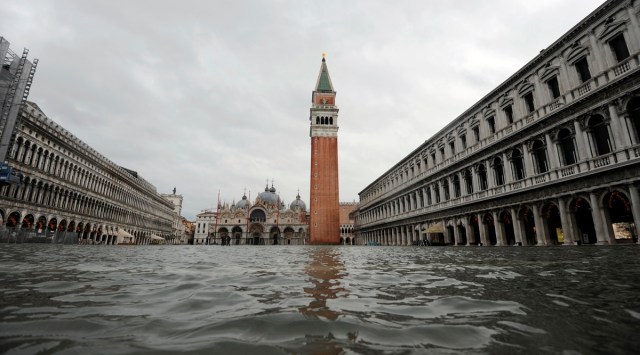- India
- International
Who can stop Venice from sinking?
In 2019, Venice experienced the worst flooding the city has seen in decades. The waters in Venice peaked at 1.87 meters that year, the second highest since official records began in 1923
 A flooded St. Mark's Square in Venice, Italy, Tuesday, Dec. 8, 2020. (Anteo Marinoni/LaPresse via AP)
A flooded St. Mark's Square in Venice, Italy, Tuesday, Dec. 8, 2020. (Anteo Marinoni/LaPresse via AP)By Urvija Mafatlal
The city of Venice, famous for its mesmerising canals, bridges and gondola rides is facing a big crisis. The Italian city, made up of more than 100 islands inside a lagoon, is starting to see a sharp decline in residents. While tourism numbers have steadily increased, even relative to the rest of Italy, Central Venice has lost roughly a third of its residents over the course of one generation. As irony may have it, the floating city is slowly, but surely sinking.
In 2019, Venice experienced the worst flooding the city has seen in decades. The waters in Venice peaked at 1.87 meters that year, the second highest since official records began in 1923. For tourists, that phenomenon was especially evident in St. Mark’s Square, one of the lowest and most popular parts of the city. In 1200 years, the famed St Mark’s Basilica has flooded 6 times with 4 of those floods occurring in the 21st century alone.
The recent flooding in Venice was caused by a combination of high spring tides and a meteorological storm surge driven by strong sirocco winds blowing north-eastwards across the Adriatic Sea. When these two events coincide, we get what is known as Acqua Alta (high water).This latest Acqua Alta occurrence in Venice is the second highest tide in recorded history. However, if we look at the top 10 tides, five have occurred in the past 20 years and the most recent was only last year. The problem is only going to get worse, as the Mediterranean Sea is projected to rise by 140 centimetres over the next century.
 Moored gondolas on an empty Grand Canal are seen in Venice on the second day of an unprecedented lockdown across of all Italy imposed to slow the outbreak of coronavirus, in Venice, Italy, March 11, 2020. (REUTERS/Manuel Silvestri)
Moored gondolas on an empty Grand Canal are seen in Venice on the second day of an unprecedented lockdown across of all Italy imposed to slow the outbreak of coronavirus, in Venice, Italy, March 11, 2020. (REUTERS/Manuel Silvestri)
This in turn could threaten many of Venice’s monuments. “When salt permeates the materials of these buildings, it crystallizes, and ascends vertically once the weather gets drier,” according to architect Kobi Karp in Architectural Digest. This will cause Venice’s buildings and monuments to “expand, crack or even explode”, says associate professor of Norwegian University of Science and Tech, Chaira Bertolin to TIME Magazine.

While the increasing flooding can be blamed in part on climate change, human activity in Venice has also contributed significantly to the problem. The sediment that the city rests on is compacting under the weight of new construction and the millions of tourists who visit. The fragile lagoon has also been impacted by the increasing number of cruise ships entering Venice, which create artificial waves that pummel the city’s foundation and infrastructure. Most significantly, decades of digging and reshaping the delta to account for bigger cruise ships has allowed more water to enter the city.
A project to protect the city from flooding has been underway since 2003 and is expected to be completed later this year. Called the MOSE Project, this initiative aims to create a series of large barriers or floodgates, raised from the seabed, to shut off the lagoon when water levels get too high. Successfully tested in 2013, the MOSE project has been delayed due to scandals and soaring costs. First proposed in 1976, the bill for this project is estimated at USD 6 billion, a large chunk of which was diverted into the accounts of corrupt politicians, including a former mayor who was arrested in 2014 for bribery.
Despite these challenges, the barriers created under the MOSE project, successfully kept the sea at bay in 2020. However, it is widely seen as a stop-gap solution and a similar project in New York was recently cancelled by then President Trump for its lack of long-term efficacy. A 2011 UNESCO report concluded that MOSE “might be able to avoid flooding for the next few decades, but the sea will eventually rise to a level where even continuous closures will not be able to protect the city from flooding. The question is not if this will happen, but only when it will happen.”
Venice could be underwater by 2100 if global warming is not curbed. Venice IS in fact sinking.
📣 For more lifestyle news, follow us on Instagram | Twitter | Facebook and don’t miss out on the latest updates!
Must Read
Apr 27: Latest News
- 01
- 02
- 03
- 04
- 05




































